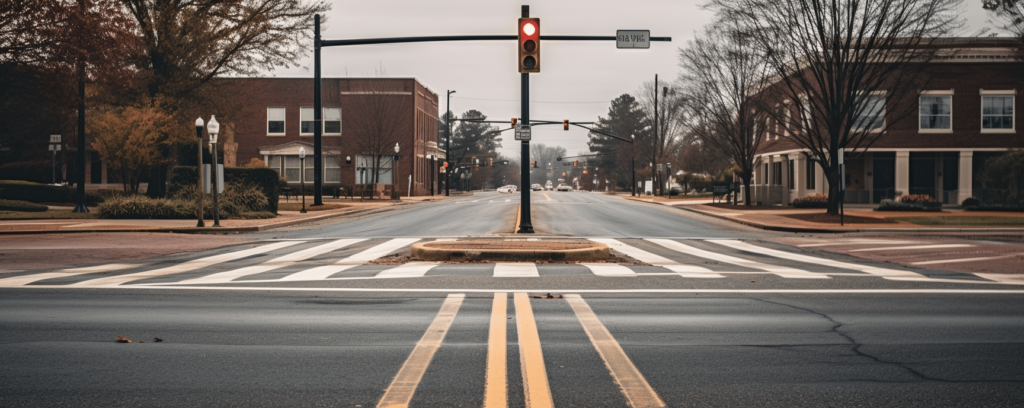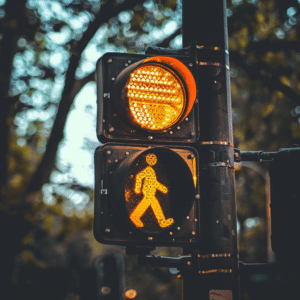When Does a Pedestrian Not Have the Right of Way? – Explained
Last updated Wednesday, April 17th, 2024

When does a pedestrian not have the right of way? This crucial question impacts both pedestrian safety and traffic flow. Contrary to common belief, pedestrians must yield to vehicles in specific scenarios, such as when signals are against them or no crosswalk is present. Our article dives into the key times pedestrians should not step forward, providing a guide through the less straightforward aspects of traffic law without jaywalking into the complexities.
Key Takeaways
- Pedestrian safety is greatly dependent on obeying traffic signals and using crosswalks appropriately, but it is also the responsibility of drivers to yield to pedestrians when they have the right of way.
- Though pedestrians have the right of way in many situations, there are specific instances where they must yield to vehicles, such as when crossing outside of marked crosswalks or against electronic traffic control devices.
- Drivers are legally required to yield to vulnerable pedestrians, including blind individuals and children, particularly in school zones and other designated areas, while both pedestrians and drivers have roles to play in preventing accidents and ensuring safety.
Get Your FREE Case Review Today
Contact us today and we will help you get the compensation that you deserve.
or Send Us Your Case DetailsGet Your FREE Case Review Today
Contact us today and we will help you get the compensation that you deserve.
or Send Us Your Case DetailsObeying Traffic Signals
Roads are like a well-choreographed dance, with traffic signals acting as the conductor. For pedestrians, crossing streets at designated crosswalks or intersections after checking for cars in all directions is akin to knowing the rhythm of the dance. Ignoring the beat can lead to discord, and in the case of traffic, potential accidents. Hence, obeying traffic signals is not just a rule but a lifesaver.
However, the responsibility doesn’t lie with pedestrians alone. Drivers too need to respect the signals and the pedestrian’s right to cross the road. A marked crosswalk is a pedestrian’s stage, and the green light or walk signal is their cue to perform. During this time, pedestrians have the right of way, and motor vehicles must yield to them. By understanding and respecting these traffic control devices, we can ensure a harmonious flow of traffic, reducing the likelihood of pedestrian accidents.
Sidewalk Use and Walking Direction
Now that we’ve understood the importance of traffic signals let’s move on to another essential aspect of pedestrian safety – the use of sidewalks and walking direction. These may seem like simple elements, but they significantly contribute to your visibility and safety. When sidewalks are available, they should be your primary pathway for walking. But what if there are no sidewalks?
In areas without sidewalks, pedestrians should walk facing traffic:
- Walk on the left side of the road to face oncoming traffic as much as possible
- Walk as far from traffic as practicable, whilst facing oncoming traffic, to increase safety
- Ensure maximum visibility for both yourself and the drivers
By following these simple precautionary measures, you can significantly reduce the risk of pedestrian accidents.
Situations Where Pedestrians Do Not Have the Right of Way
Just as there are situations where pedestrians have the right of way, there are instances where they don’t. It may come as a surprise, but pedestrians do not always have the right of way. An intersection may seem like a simple crossroad, but it’s a hub of complex traffic rules and rights. For instance, at unmarked crosswalks or intersections, pedestrians are required to yield to vehicles when they pose an immediate hazard.
Moreover, pedestrians must yield to oncoming vehicles when crossing outside of marked crosswalks as stipulated by CVC §21954. When it comes to intersections with electronic traffic control, pedestrians have the green light to cross only when they receive a walk signal or green light. In scenarios where a pedestrian’s actions, such as jaywalking, prevent an accident from being avoided, they are considered at fault. It is crucial for pedestrians to be cautious and attentive when pedestrians cross the street.
Understanding these nuances of pedestrian rights can be the difference between a safe walk and a potentially fatal pedestrian accident.
Ignoring Walk Signals or Crossing Against Lights

Furthermore, pedestrians must:
- Allow vehicles already in the crosswalk to pass through before entering when walk signals indicate it is their turn to cross.
- Exercise care for their own safety, which includes using marked crosswalks and obeying traffic signals.
- Not stop or delay traffic unnecessarily while in a crosswalk, whether marked or unmarked.
Failure to do so can result in legal penalties and a jeopardized safety.
Special Considerations for Vulnerable Pedestrians
Pedestrian safety is essential for all, but for some, it requires extra care and consideration. Vulnerable pedestrians, such as blind individuals and children, may have difficulty navigating traffic or act unpredictably. Hence, they require additional caution from drivers and fellow pedestrians.
Drivers and other pedestrians must be particularly aware of blind pedestrians’ right of way when they detect the use of a white cane or guide dog. Similarly, children often have difficulty judging traffic risks and may act unpredictably, requiring additional caution from drivers and fellow pedestrians.
Special care must be taken in school zones, which are particularly sensitive areas due to the frequent presence of child pedestrians.
Accommodating Blind Pedestrians
Among the vulnerable pedestrians, blind or visually impaired individuals warrant particular attention. They often use guide dogs or white canes for navigation and mobility. These aids serve as an important signal for drivers to yield, ensuring their safety and right of way.
When a driver sees a pedestrian with a guide dog or a white cane, they should come to a complete stop and allow the pedestrian to cross safely. The presence of a white cane or a guide dog typically indicates that the pedestrian may have limited or no vision, requiring extra precautions by drivers. By understanding and respecting these signals, drivers can greatly enhance road safety for blind pedestrians.
Children and School Zones
Children, with their spontaneous and unpredictable nature, pose a unique challenge when it comes to pedestrian safety. School zones in Alabama are areas near school buildings and extend to adjacent roadways, with speed limits typically reduced to 25 mph within 500 feet when children are present. This reduction in speed limit is a crucial measure to ensure the safety of children who may suddenly step onto the road.
Drivers must remain cautious even outside of standard school hours due to after-school programs that can extend to 6 p.m., increasing the chance of children being present. The unpredictable movements and inability to accurately judge traffic risks make children particularly vulnerable. Hence, drivers and pedestrians must exercise increased vigilance in school zones and areas frequented by children.
Vehicle and Driver Responsibilities
While pedestrians have their part to play in ensuring road safety, drivers, especially a reasonable driver, carry a significant share of the responsibility as well. They are accountable for maintaining legal speed limits to ensure pedestrian safety. Accumulating a certain number of points for traffic violations can lead to license suspension or revocation by the DMV.
Moreover, drivers must act with increased caution in school zones, where children are more likely to be crossing roads. When approaching a crosswalk, it is crucial for drivers to slow down and be prepared to stop for pedestrians. Even if a pedestrian is jaywalking, drivers have the obligation to try to avoid hitting them. By understanding and adhering to these responsibilities, drivers can greatly contribute to pedestrian safety.
Avoiding Collisions
Pedestrian safety is not just about following rules, it’s also about proactive measures to avoid accidents. Drivers must use heightened caution when turning or reversing near blind pedestrians due to the reduced audibility of electric or hybrid vehicles. It is prohibited for drivers to use their horn around blind pedestrians as it could cause confusion and startle them, impacting their safety.
Stopping within a crosswalk is illegal as it presents dangers for blind pedestrians who might be forced to navigate around the vehicle, potentially into the path of other traffic. Drivers are expected to avoid passing vehicles stopped at crosswalks due to the possibility of hidden pedestrians, especially children in school zones. Even with pedestrians exhibiting unpredictable behavior, preventative measures must be taken by drivers, such as stopping or reducing speed to ensure safety.
Poor visibility conditions, such as at night or in bad weather, require motor vehicle drivers to be especially vigilant to prevent collisions with pedestrians.
Yielding to Pedestrians in Unclear Situations
On the road, clarity is not always a given. In unclear situations, drivers should yield to pedestrians, especially those who are blind or visually impaired. If a blind pedestrian withdraws their cane and steps away from the intersection, drivers can take this as a signal that it is safe to proceed.
However, drivers must always yield to blind pedestrians, recognizing that their navigation relies on the consistent behavior of others, including drivers stopping at crosswalks. By understanding these nuances, drivers can contribute to a safer and more inclusive road environment for all.
Consequences of Failing to Follow Traffic Laws
Every action has a consequence, and this holds true for pedestrians who fail to follow traffic laws. Adherence to traffic signals is mandated by law for pedestrians. Failure to comply with crossing lights can result in legal penalties under Alabama crosswalk laws. These penalties serve as a deterrent and a stark reminder of the importance of following traffic laws.
But the consequences aren’t just legal. The disregard for traffic laws can lead to accidents, endangering the safety of pedestrians and other road users. Therefore, understanding and adhering to traffic laws is not just a legal obligation but a moral one, essential for maintaining one’s safety and that of others.
Pedestrian Liability in Accidents
When accidents occur, it’s not always the driver who is at fault. Pedestrians may be held responsible for an accident if they enter traffic and a driver cannot reasonably stop in time. Crossing intersections against a traffic signal or ‘Don’t Walk’ signal can result in loss of right of way and pedestrian liability.
When pedestrians do not exercise due care by running in front of approaching vehicles, they may be held legally accountable if a hazard is caused. These instances of pedestrian liability serve as a reminder that pedestrian safety involves not just following the rules but also respecting the rights and safety of other road users.
Shared Fault and Comparative Negligence

- the pedestrian not having the right of way
- intoxication
- texting
- being in unauthorized areas
For instance, pedestrians should avoid abruptly stepping off the curb into oncoming traffic, as this can lead to reduced compensation due to shared fault in the event of a collision. Understanding these concepts is critical in appreciating the complex nature of traffic laws and the shared responsibility of all road users in maintaining safety.
Tips for Ensuring Pedestrian Safety
Now that we’ve explored the various aspects of traffic laws and pedestrian safety, let’s look at some practical tips for pedestrians to ensure their safety.
A key aspect of pedestrian safety is visibility. Pedestrians should increase their visibility by wearing brightly colored clothing, such as red light-reflecting garments, and using a walk light when walking at night.
In addition to visibility, pedestrians can ensure their safety by making eye contact with drivers and following road rules while staying alert to their surroundings. These simple yet effective tips can greatly enhance pedestrian safety and help create a safer road environment for all.
Making Eye Contact with Drivers
One of the simplest yet most effective safety tips for pedestrians is to make eye contact with drivers before crossing. This small act of communication ensures that the driver has seen you and acknowledges your intent to cross.
Assuming visibility without making eye contact can result in drivers being unaware of the pedestrian’s presence. Establishing eye contact or otherwise ensuring that drivers are aware of the pedestrian enhances the likelihood of safely crossing the street. This small act can significantly enhance your safety on the road.
Following Road Rules and Being Alert
Another crucial aspect of pedestrian safety is adhering to road rules and staying alert. Pedestrians must:
- Adhere to traffic signals and may only cross with a walk signal
- Observe traffic control devices and signage when crossing streets
- Follow the rules of the road, including obeying signs and signals
Following these guidelines is essential for pedestrian safety, especially to avoid situations where vehicles might hit pedestrians.
Before crossing, pedestrians should always:
- Look in multiple directions to monitor traffic conditions
- Be vigilant and aware of vehicles in areas such as driveways and parking lots
- Stay off phones to avoid distractions and stay alert to their surroundings
By combining alertness with adherence to road rules, pedestrians can significantly enhance their safety on the road.
Frequently Asked Questions
Do pedestrians always have the right of way True or false?
False. While pedestrians generally have the right of way, they do not always have it, as right of way is governed by traffic signs or traditional traffic rules.
Do humans always have the right of way?
No, pedestrians do not always have the right of way, but motorists are required to avoid hitting them, even when pedestrians do not have the right of way. This is to ensure their safety, and it is a legal responsibility.
Do pedestrians have right of way in the USA?
Yes, pedestrians generally have the right of way in crosswalks and at intersections with traffic lights in the USA, but there are exceptions, and they must also follow traffic laws and signals.
What should pedestrians do if there are no sidewalks?
Pedestrians should walk on the left side of the road, facing oncoming traffic, and as far from traffic as possible for safety.
What responsibilities do drivers have towards blind pedestrians?
Drivers have a responsibility to yield to blind pedestrians, especially those using guide dogs or white canes, and allow them to cross the road safely. Be sure to come to a complete stop when you see a blind pedestrian approaching.






